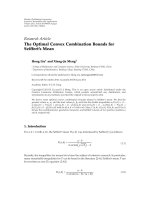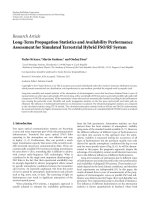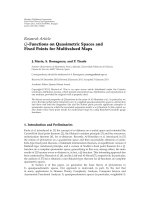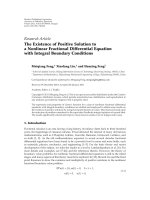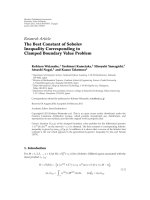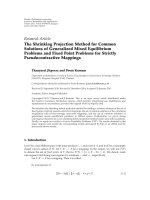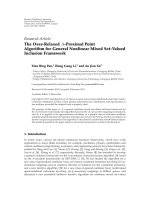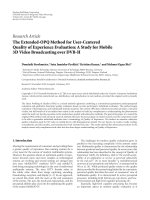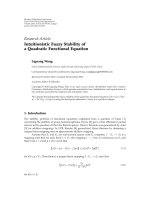Báo cáo hóa học: " Research Article The Personal Hearing System—A Software Hearing Aid for a Personal Communication System" ppt
Bạn đang xem bản rút gọn của tài liệu. Xem và tải ngay bản đầy đủ của tài liệu tại đây (873.75 KB, 9 trang )
Hindawi Publishing Corporation
EURASIP Journal on Advances in Signal Processing
Volume 2009, Article ID 591921, 9 pages
doi:10.1155/2009/591921
Research Article
The Personal Hearing System—A Software Hearing Aid for
a Personal Communication System
Giso Grimm,
1
Gw
´
ena
¨
el Guilmin,
2
Frank P oppen,
3
Marcel S. M. G. Vlaming,
4
and Volker Hohmann
1, 5
1
Medizinische Physik, Carl-von-Ossietzky Universit
¨
at Oldenburg, 26111 Oldenburg, Germany
2
THALES Communications, 92704 Colombes Cedex, France
3
OFFIS e.V., 26121 Oldenburg, Germany
4
ENT/Audiology, EMGO Institute, VU University Medical Center, 1007 MB Amsterdam, The Netherlands
5
H
¨
orTech gGmbH, 26129 Olde nburg, Germany
Correspondence should be addressed to Giso Grimm,
Received 15 December 2008; Revised 27 March 2009; Accepted 6 July 2009
Recommended by Henning Puder
A concept and architecture of a personal communication system (PCS) is introduced that integrates audio communication and
hearing support for the elderly and hearing-impaired through a personal hearing system (PHS). The concept envisions a central
processor connected to audio headsets via a wireless body area network (WBAN). To demonstrate the concept, a prototype PCS is
presented that is implemented on a netbook computer with a dedicated audio interface in combination with a mobile phone.
The prototype can be used for field-testing possible applications and to reveal possibilities and limitations of the concept of
integrating hearing support in consumer audio communication devices. It is shown that the prototype PCS can integrate hearing
aid functionality, telephony, public announcement systems, and home entertainment. An exemplary binaural speech enhancement
scheme that represents a large class of possible PHS processing schemes is shown to be compatible with the general concept.
However, an analysis of hardware and software architectures shows that the implementation of a PCS on future advanced cell
phone-like devices is challenging. Because of limitations in processing power, recoding of prototype implementations into fixed
point arithmetic will be required and WBAN performance is still a limiting factor in terms of data rate and delay.
Copyright © 2009 Giso Grimm et al. This is an open access article distributed under the Creative Commons Attribution License,
which permits unrestricted use, distribution, and reproduction in any medium, provided the original work is properly cited.
1. Introduction
The motivation for this study is to investigate the per-
spectives of improving hearing support and its acceptance
by integrating communication services and hearing sup-
port systems. Hearing aids are the standard solution to
provide hearing support for hearing-impaired persons. In
many adverse conditions, however, current hearing aids
are insufficient to alleviate the limitations in personal
communication and social activities of the hearing-impaired.
Most challenging problems are howling due to acoustic
feedback from the hearing aid receiver to the microphones
[1], interference of cell phone radio frequency components
with hearing aids [2], low signal-to-noise ratios (SNRs) in
public locations caused by competing noise sources, and
reverberation [3]. A number of partial solutions addressing
these problems are available in current hearings aids. Signal
processing solutions comprise noise reduction algorithms
like spectral subtraction and directional microphones [3].
Other assistive solutions comprise direct signal transmission
by telecoils, infrared, and radio systems [4, 5]. Recent tech-
nological progress opens up possibilities of improving these
solutions. New bridging systems, currently intended mainly
for connection to communication and home entertainment
devices, are based on the digital BlueTooth protocol, for
example, the ELI system [6]. New scalable algorithms can be
adopted to different listening situations and communication
environments and are expected to be beneficial for the end-
user either in terms of improved speech intelligibility or
by enhancing speech quality and reducing listening effort
[7]. A combination of the new signal processing schemes
and communication options has not widely been explored
2 EURASIP Journal on Advances in Signal Processing
yet, and the final user benefit remains to be investigated.
Dedicated prototype systems as investigated in this study
might facilitate this type of research.
Contrary to a hearing-impaired with moderate or strong
hearing loss, a person with mild hearing loss, or, more
generally, any person with light-to-moderate problems in
hearing under adverse circumstances, will not wear a hearing
aid nor other hearing support system. Hearing support sys-
tems which are add-ons to existing communication devices
might be beneficial for those users and their acceptance is
expected to be higher than that of conventional hearing
aids.
Another factor that influences and might facilitate the
further development of hearing support systems is the avail-
ability of standard hardware and open software for mobile
devices, for example, the iPhone [8] or the GooglePhone [9].
These devices can act as a central processor for hearing aids
with access to binaural audio information and the advantage
of increased processing performance [10]. Based on such
scalable systems, the integration of hearing support systems
for slight-to-moderate hearing losses with communication
applications seems to be feasible in principle, but is yet to be
assessed in more detail. One step toward that direction is low-
delay real-time signal processing systems based on standard
hard- and software, such as the Master Hearing Aid (MHA)
[11], a development framework for hearing aid algorithms.
Another hardware-related factor is the development of
Wireless Body Area Networks (WBANs) that can be seen
as an enabling technology for mobile health care [12]and
that could mediate the communication between a central
processor and audio headsets attached to the ear like hearing
aids.
In summary, recent developments open up the possibility
of merging the functionality of traditional hearing aids
and other hearing support systems for slight-to-moderate
hearing losses on scalable hardware. This combination will
be defined as a Personal Hearing System (PHS). Further-
more, the integration of this PHS with general and new
communication applications of mobile phones and PDAs
to define a Personal Communication System (PCS) may
lead to new applications and improved hearing support.
User inquiries regarding the acceptance of such a PCS have
been carried out within the EU project HearCom [13], and
its general acceptance was demonstrated, provided that the
device is not larger than a mobile phone and includes its
functionality. Some specific solutions to this already exist,
but audio applications with scalable listening support for
different types of hearing losses and having a connection to
personal communication and multimedia devices are not yet
available. The aim of this study is, therefore, to establish a
basis for further research and development along these lines.
In Section 2, the proposed architecture of a PCS is outlined.
Section 3 describes the implementation of a prototype PCS
which runs on a netbook computer and hosts four represen-
tative signal enhancement algorithms. A first evaluation of
the hardware requirements (e.g., processing power, wireless
link requirements), of the software requirements (scalable
signal processing), and of the expected benefit for the end
users is performed using this PCS prototype.
2. PCS Architecture
The PCS is a hand-held concentrator of information to
facilitate personal communication. Figure 1 shows a block
diagram of the projected PCS and its applications. The PCS
is a development based on new advanced mobile telephones
and Personal Digital Assistants (PDAs). The reason for
selecting a mobile phone as a PCS platform is the availability
of audio and data networking channels, like GSM, UMTS,
BlueTooth, and WiFi. A global positioning system—if
available—can be utilized by public announcement services.
Audio is played to the user via a pair of audio headsets.
These audio headsets are housing loudspeakers/receivers for
audio playback. Each audio headset also has two or three
microphones, which can be configured to form a directional
microphone for picking up environmental sounds, and the
own voice of the user for phone application. As an option, the
audio headsets provide audio processing capabilities similar
to hearing aids.
A short-range wireless link (Wireless Body Area Net-
work, WBAN) provides the connection between the PCS and
the audio headsets, and optionally between the two audio
headsets at the left and right ears. Mid-range and wide-range
links are used to establish connections to telecommunication
network providers and to local information services. All links
are part of the wireless Personal Communication Link (PCL),
which supplies information to the PCS and between the PCS
and the audio headsets, as a successor for the inductive link
(telecoil) of current hearing aids.
A key application on the PCS is the PHS: the audio
communication channels of the PCS, for example, telephony,
public announcement, and home entertainment, are pro-
cessed in the PHS with personalized signal enhancement
schemes and played back through the audio headsets.
In addition to the PCS audio communication channels,
the PHS can process environmental sounds picked up by
the headset microphones near the user’s ears. Processing
methods may differ depending on the input, that is, acoustic
input or input through the PCS communication channels.
The functionality of the PHS covers that of a conventional
hearing aid, and adds some additional features. (i) Increased
connectivity: the PCS provides services, which can connect
external sources with the PHS. (ii) Advanced audio signal
processing schemes: the computational power and battery
size of the central processing device allows for algorithms
which otherwise would not run on conventional hearing
aids. (iii) Potential of production cost reduction: usage
of standard hardware may reduce production, marketing,
distribution, and service costs if consumer headsets with
slight modifications, for example, addition of microphones
for processing of environmental sounds can be used (which
is limited to subjects with mild to moderate hearing loss).
2.1. Distributed Processing. For processing the PCS audio
communication channels, an unidirectional link from the
central processor to the headsets is sufficient and the link
delay is not critical as long as it remains below 50–100 ms.
Processing environmental sounds in the central processor,
however, requires a bidirectional link which needs further
EURASIP Journal on Advances in Signal Processing 3
Hearing aids
with basic
processing
PCS
PCL
(WBAN)
PCL:
GSM, UMTS,
BlueTooth, WLAN
Advanced
processing
Te xt display
Public announcement
Home entertainment
Te l e phone
PHS
PCS-PHS link
Audio stream
Te xt and control
Figure 1: Architecture of a Personal Communication System (PCS)
hosting the personal hearing system. The PCS (large shaded box) is
hosted on an advanced mobile phone. The Personal Hearing System
(PHS) is a software component for signal enhancement, processing
audio output of the PCS communication channels and processing
environmental signals. The Personal Communication Link (PCL)
transfers environmental sounds to the PHS and the processed
sounds or control information back to the audio headsets.
consideration. In general, all processing blocks can be run
either on the audio headsets or on the central processor.
The optimal choice for each processing block depends
on several issues: (i) The computational performance and
battery capacity of the audio headsets is typically low and
does not allow complex algorithms. (ii) The central processor
or the PCL might not be available continuously because of
wireless link breakdowns. Therefore, at least basic processing
like amplification for hearing loss correction is required to
run on the audio headsets. (iii) Depending on the properties
of the PCL, the delay might exceed the tolerable delay for
processing of environmental sounds [14], and will constraint
the algorithms on the central processor. Link delays smaller
than 10 ms would allow routing the signal through the
central processor. In typical hearing aid applications, signal
enhancement schemes precede the processing blocks for
hearing loss correction (e.g., amplification and compres-
sion). To avoid the transmission of several signal streams,
only one set of successive processing blocks can be run
on the central processor. As to whether emerging WBAN
technology might be powerful enough to achieve the delay
limit seems unclear yet. If the total link delay is longer than
about 10 ms, the signal path needs to remain completely
on the audio headsets. Then, processing on the central
processor is restricted to signal analysis schemes that control
processing parameters of the signal path, for example,
classification of the acoustical environment, direction of
arrival estimation, and parameter extraction for blind source
separation. In general, it seems feasible that these complex
signal analysis schemes and upcoming complex processing
performance demanding algorithms for Auditory Scene
Analysis [15] might not necessarily be part of the signal path.
The projected architecture might, therefore, be suited for
these algorithms, which could benefit from the high signal
processing and battery power of the central processor. Other
requirements for the link are bandwidth and low power
consumption: to allow for multichannel audio processing,
several (typically two or three) microphone signals from
each ear are required, asking for sufficient link bandwidth.
Additionally, if signals are transmitted in compressed form,
the link signal encoder should not modify the signal to
avoid artifacts and performance decreases in multichannel
processing. To ensure long battery life, the link should use
low power. To reduce the link power consumption, the
PHS could provide only advanced processing on demand.
Switching on advanced processing and the link might be
either controlled manually or by an automatic audio analysis
in the headsets.
The architecture of the PHS with a central processor gives
the ability to process binaural information in the central
processor and unilateral information either in the central
processor or in the audio headsets. Considering typical
processing schemes in hearing aids, unilateral processing
comprises dynamic compression, single channel noise reduc-
tion, and feedback cancellation. Typical applications of
the central processor are binaural and multimicrophone
methods, for example, binaural ambient noise reduction,
beamformer, and blind source separation [3]. If the link delay
is not sufficiently small to route the signal path through the
central processor, binaural processing can still be achieved
assuming a signal analysis algorithm running on the central
processor processes signals from left and right side and
controls the signal path on both sides.
3. Implementation of a Prototype System
To assess the PCS architecture and applications experi-
mentally, a prototype PCS has been implemented on a
small notebook computer “netbook” in combination with
a Smartphone. To demonstrate PHS applications, several
signal enhancement algorithms have been realized on the
PCS prototype using the MHA algorithm development envi-
ronment, see Section 3.2.1. A dedicated audio interface that
was developed within the EU HearCom project to connect
audio headsets to the netbook is described in Section 3.2.2.
A phone service as a prototype application of the PCS,
implemented on a Smartphone, is described in Section 3.3.2.
One signal enhancement algorithm (coherence-based de-
reverberation [7]) was taken as an example and has been
tested on its conformity with the concept of the PHS.
4 EURASIP Journal on Advances in Signal Processing
3.1. Architecture. See Figure 2 for a schematic signal flow
of the prototype system. The PHS is implemented using a
separate notebook computer. Notebook computers deliver
sufficient performance for audio signal processing. Selecting
signal processing algorithms carefully and using perfor-
mance optimization techniques allows for stripping down
the PC platform. However, a floating point processor is
required for prototype algorithms and prevents using fix
point processor-based PDAs or Smartphones. Using floating
point algorithms enables fast prototyping and very early field
testing. In a later step, it is necessary to recode positively
evaluated algorithms to a fixed point representation and
install these on PDAs or Smartphones. PCS services are
implemented on a Smartphone with networking capabilities.
The PCS-PHS link is realized as a WiFi network connection.
The audio headsets are hearing aid shells with microphones
and receiver, without signal processing capabilities. The
audio headsets are connected to the PHS via cables and
a dedicated audio interface. The audio headset signal pro-
cessing capabilities are simulated on the central processor.
Figure 3 shows a netbook-based PHS prototype.
3.2. Hardware Components. In the following sections, the
hardware components of the prototype implementation are
described.
3.2.1. Netbook: Asus Eee PC. For the prototype system, a
miniature notebook has been used as a hardware accelerated
floating point processor for the PHS: the Asus Eee PC is a
small and lightweight notebook PC, its size is about 15
∗
22 cm, weighting 990 grams. It provides an Intel Celeron
processor M, running at a clock rate of 630 MHz. To achieve
low delay signal processing in a standard operating system
environment, a Linux operating system (UbuntuStudio 8.04)
with a low-delay real-time patched kernel (2.6.24-22-rt) has
been installed. For comparison, the system was also installed
on an Acer Aspire netbook PC and a standard desktop PC.
3.2.2. Dedicated Audio Interface. A detailed market survey
showed that commercially available audio interfaces cannot
satisfy all requirements for the mobile PHS prototype. High-
quality devices as used in recording studios offer the required
signal quality and low latency but are not portable because of
size, weight, and external power supply. Portable consumer
products do not offer quality, low latency, and required
a number of capture and playback channels. Therefore, a
dedicated USB audio interface has been developed which
fulfills the requirements of the PHS prototype. The audio
interface has been developed in two variants: a device with
four inputs and two outputs to drive two audio headsets with
two microphones in each headset (USBSC4/2), and a device
with six inputs and two outputs, for two audio headsets
with three microphones each (USBSC6/2). The basis for both
devices is a printed circuit board (PCB). The USBSC4/2
contains one PCB as shown as PCB1 in Figure 4. Assembled
are two stereo ADs (four channels) and one stereo DA (two
channels). A microcontroller (μC) implements the USB2.0
interface to PC hardware. A complex programmable logic
Smartphone
Hearing aid
shells w/o
processing
Netbook
Audio
interface
Advanced
processing
Te xt display
Public announcement
Home entertainment
Te l e phone
PHS
GSM, UMTS,
BlueTooth, WLAN
Basic
processing
PCS-PHS link
LAN (W
iFi o
r ethernet)
Audio stream
Te xt and control
Figure 2: Prototype implementation of the PCS. The PCS services
are hosted in a Smartphone, the PHS (mainly signal processing) is
hosted in a portable PC. The PC connects to the hearing aid shells
via a dedicated audio interface, architecture.
Figure 3: PHS prototype based on the Asus Eee PC, with a
dimension of 22
×15 cm and a weight of 1.2 kg, including the sound
card and audio headsets.
device (CPLD) serves as glue-logic between μC and AD/DA.
The advantage of CPLDs is the possibility to reconfigure
their interconnecting structure in system. This feature is
used to connect two PCBs and build one device with
more channels (USBSC6/2). A simple reconfiguration of the
CPLDs and a software exchange on the μC(exchangeof
EURASIP Journal on Advances in Signal Processing 5
Stereo
DA
Stereo
DA
Stereo
AD1
Stereo
AD1
Stereo
AD2
Stereo
AD2
USB interface to PC
FIFOs
Master
CPLD
Slave
CPLD
PCB1
PCB2
μC
Figure 4: Architecture of the dedicated audio interface, with four
inputs and two outputs (PCB1 only), or six inputs and two outputs
(PCB1 and PCB2).
firmware) enables the configuration of other devices in the
shortest time, as, for example, a device with four inputs and
outputs, or eight inputs and no outputs. The hardware is also
applicable outside the scope of hearing aid research: with
minor modifications, it can be used as a mobile recording
device or as consumer sound card for multimedia PCs.
For future usage of the developed hardware, device
variations in number and type of channels depending on
user requirements are quickly retrievable. The architecture
is extendable by a hardware signal processing unit for user-
defined audio preprocessing by exchanging the CPLD with
more complex components like field programmable logic
devices (FPGA). This extension would decrease the CPU load
of the host PC, or would allow for a higher computational
complexity of the algorithm. It has to be stated though that
the implementation of algorithms in FPGAs using a fixed
point hardware description language (HDL) like VHDL or
Verilog is even more elaborate than transferring floating
point SW to fixed point. Thus, this proceeding is only
adequate for well evaluated and often used algorithms like,
for example, the FFT due to high nonrecurring engineering
costs.
The developed audio interface is a generic USB2.0 audio
device that does not require dedicated software drivers for
PCs/Notebooks running under the Linux operating system.
The device utilizes the USB2.0 isochronous data transfer
connection for low latency, and, therefore, does not work
with USB1.
The audio interface is equipped with connectors to
directly connect two hearing aid shells housing a receiver and
up to three microphones. The device provides a microphone
power supply. The USB audio interface is powered via the
USB connection. RC filters and ferrite beads are used to
suppress noise introduced by the USB power supply. One RC
filter is placed directly at the supply input. Furthermore, at
each AD- and DA-converter, one filter is placed close to the
analog and the digital supply, respectively. Additionally, noise
is suppressed by the use of ferrite beads in each supply line of
each converter.
3.3. Software Components. In the following sections, the
major software components used in the PCS prototype
implementation are described.
3.3.1. PHS Algorithms. In the PHS prototype four repre-
sentative signal enhancement schemes have been imple-
mented: single-channel noise suppression based on percep-
tually optimized spectral subtraction (SC1), Wiener-filter-
based single-channel noise suppression (SC2), spatially pre-
processed speech-distortion-weighted multichannel Wiener
filtering (MWF), and binaural coherence dereverberation
filter (COH) [7]. Individually fitted dynamic compression
and frequency-dependent amplification was placed after the
signal enhancement algorithm to compensate for the user’s
hearing loss. Hearing loss compensation without any specific
signal enhancement algorithm is labelled REF. The MHA was
used as a basis of the implementation [11].
The prototype algorithms are processed at a sampling
rate of 16 kHz in blocks of 32 samples, that is, 2 ms. Audio
samples are processed with 32 Bit floating point values, that
is,fourbytespersample.
As an example, we look at the coherence-based dere-
verberation filter in more detail: the microphone signal is
transformed into the frequency domain by a short-time fast
Fourier transform (FFT) with overlapping windows [16].
At both ears, the algorithm splits the microphone signals
X
l
and X
r
into nine overlapping frequency bands. In each
frequency band k, the average phase ϕ across FFT bins ν
belonging to the frequency band k is calculated, ϕ(k)
=
∠
ν
W(k, ν)X(ν). The weighting function W(k, ν)defines
the filter shape of the frequency band, see [11] for details.
Also, ϕ is implicitly averaged across time over the length of
one analysis window. Comparing the phase with the phase of
the contralateral side results in the interaural phase difference
(IPD) within a frequency band. The phase difference ϕ
l
−
ϕ
r
is represented as a complex number on the unit circle,
z
= e
j(ϕ
l
−ϕ
r
)
. The estimated coherence is the gliding vector
strength c of z, c
=|z
τ
|, with the averaging time constant
τ. The estimated coherence is directly transformed into
a gain by applying an exponent α, G
= c
α
. This gain
is applied to the corresponding frequency band prior to
its transformation back to the time domain. A detailed
description of the algorithm and its relation to a cross-
correlation based dereverberation algorithm can be found in
[17].
3.3.2. PCS-PHS Link for Testing Multimedia Applications. To
provide ways to connect PCS audio communication streams
to the PHS, a specific network audio interface has been
implemented in the PHS. Together with a sender application,
this interface forms the PCS-PHS link, which is using the
Internet Protocol Suite (TCP/IP). The link can be established
on demand, and contains a protocol to select appropriate
mixing strategies for different signal sources: the level of
the source signal can be matched with the environmental
sound level, and environmental sounds can be suppressed
for better speech intelligibility or alarm signal recognition.
The mixing configuration is followed by the audio stream.
6 EURASIP Journal on Advances in Signal Processing
Whenever a phone connection is established, the sender
application in the PCS is connecting to the PCS-PHS link
and is recoding the phone’s receiver output for transmission
to the PHS. To avoid drop-outs in the audio stream, the
signal from the phone has to be buffered, introducing a
delay between input and output. To reduce the delay caused
by the WiFi connection, the packet size was reduced to a
minimum. The total delay varies between 360 and 500 ms.
The long delay is specific to the prototype implementation
with a WiFi link; the final application will not include the
WiFi link between PCS phone service and PHS, since both
services are then hosted on the same machine. Via a cable-
bound network, connection delays in the order of 5ms can
be reached, for example, by using the “NetJack” system
[18] or with “soundjack” [19]. An alternative approach is
an analog connection. However, this would not allow for
sending control parameters to the PHS.
3.4. Evaluation Results
3.4.1. Computational Complexity and Powe r Consumption.
The computational complexity of the PHS prototype system
is estimated by measuring the CPU time needed to process
one block of audio data, divided by the duration of one
block. For real-time systems, this relative CPU time needs
to be below one. For most operating systems, the maximum
relative CPU time depends also on the maximum system
latency and the absolute block length. A detailed discussion
of relative CPU time and real-time performance can be found
in [11]. The relative CPU time of the PHS running the
four respective signal enhancement algorithms is shown in
Ta bl e 1.
For a portable PHS, a long battery runtime is desirable.
The battery runtime of the PHS prototype has been mea-
sured by continuously measuring the battery voltage while
running the PHS with the respective signal enhancement
algorithms. The battery was fully charged before each
measurement. The time until automatic power-down is given
in Tab l e 1. During the test, the netbook lid was closed and
the display illumination was turned off. The measurement
was performed once. To check that the battery age did
not significantly influence the results, the first measurement
was repeated. No significant differences have been observed.
However, slight variations might have been caused by
additional CPU load caused by background processes of
the operating system, and by differences between the access
to other hardware, for example, memory. The correlation
between total CPU load and the battery time is very high
for the Asus Eee PC and low for the Acer Aspire one. The
low correlation between CPU usage and battery runtime for
the Acer Aspire one might be an indication for a less efficient
hardware.
3.4.2. Benefit for the End User. The algorithm performance in
terms of speech recognition thresholds (SRTs) and preference
rating has been assessed in the HearCom project in a large
multicenter study [7]. As an example, speech recognition
threshold improvement data from [7]isgiveninTa bl e 2.
−5 −4 −3 −2 −1 12345
0
5
10
15
20
25
Hearing impaired
Nor mal hearing
(%)
“REF’’ is better Preference “COH’’ is better
Figure 5: Preference histogram. COH is preferred against the
reference condition “REF” by 80.6% of the hearing impaired and by
61.1% of the normal hearing subjects. The categories 1–5 are “very
slightly better,” “slightly better,” “better,” “much better,” and “very
much better.”
The standard deviation of the results across four different
test sites is marginal, which proves the reliability of the PHS
prototype as a research and field testing hearing system.
While the speech intelligibility could not be improved by the
algorithm COH, it was preferred by most subjects against
“REF” processing (i.e., only hearing loss correction), see
Figure 5. Hearing-impaired subjects show a clearer prefer-
ence for COH than normal hearing subjects do. The listening
effort can be reduced by COH if the SNR is near 0 dB [20].
Even if the SRT cannot be improved by the algorithm, the
reduction of listening effort is a major benefit for the user.
Furthermore, a combination with the MWF algorithm is
possible and indicated, since both methods exploit different
signal properties (directional versus coherence properties).
An improvement of the beamformer performance is likely if
the coherence filter is preceding the beamformer [21].
3.4.3. Requirements towards the PCL. The requirements
toward the wireless link between headsets and central
processor varies with the algorithms. Estimated data rates for
4-byte sample formats without any further data compression
are given in this section as a worst-case scenario. The
link bandwidth required to transmit all six microphone
channels is 768 bytes per block in the direction from one
headset to the central processor and 256 bytes per block
in the other direction (two receiver signals). With two
headsets and 500 blocks per second this leads to a required
(uncompressed) bandwidth of 3 MBit/s from headsets to the
central processor and 1MBit/s back to the headsets. The
requirements for the coherence filter “COH” toward the
link bandwidth in three scenarios are presented. The trivial
scenario is the condition where the algorithm is running on
the central processor, where the full audio signal of both
EURASIP Journal on Advances in Signal Processing 7
Table 1: Performance of the PHS prototype system. In addition to the algorithm CPU time, the CPU time used for signal routing,
resampling, overlap-add, spectral analysis, and hearing loss correction was measured (labelled MHA), and also the CPU time used by the
jackd sound server and the sound card interrupt handler.
Algorithm
Asus Eee PC 4G Acer Aspire one Desktop PC
Celeron M 630 MHz Atom N270, 1.6 GHz Pentium 4, 3 GHz
% CPU batt. % CPU batt. % CPU
SC1 23.3% 3h14
20.5% 2h28
8.5%
SC2 12.0% 3h19
11.0% 2h27
4.0%
MWF 16.7% 3h16
17.0% 2h09
4.5%
COH 3.5% 3h22
4.5% 2h27
1.0%
MHA 33.1% 30.5% 12.0%
jackd 6.0% 4.8% 2.2%
IRQ 4.5% 4.2% 1.0%
Table 2: Speech recognition threshold (SRT) improvement (i.e.,
difference to identity processing with hearing loss correction
“REF”) in dB SNR for the four algorithms, measured at four test
sites. The standard deviation across test site is marginal, which
proves the reliability of the PHS prototype as a research and field
testing hearing system, data from [7].
Test site
SRT improvement/dB
SC1 SC2 MWF COH
10.0−0.2 7.1 0.2
20.0
−0.1 6.7 −0.2
3
−0.1 −0.1 6.2 −0.5
40.2
−0.3 6.7 0.1
Average 0.1 −0.1 6.7 −0.1
Standard deviation 0.14 0.09 0.36 0.32
sides is required, that is, 1 MBit/s in each direction. Lower
bandwidth is required if only signal analysis is performed
in the central processor: the phase information in nine
frequency channels of each side and for each signal block
is required, leading to a headset-to-processor bandwidth
requirement of 281.25 kBit/s. For the other direction, nine
gains are transmitted, with identical gains for both sides. This
results in a bandwidth requirement of 140.625 kBit/s. The
third scenario is a situation where signal analysis and filtering
are processed in the audio headsets, and the link is only used
for data exchange between the audio headsets. Then only the
phase information is exchanged, that is, 140.625 kBit/s are
required in each direction. These bandwidth requirements
do not include data compression. With special signal cod-
ing strategies, the bandwidth requirements can be further
reduced. The bandwidth of current hearing aid wireless
systems is in the range of 0.1–100 kBit/s, with a range of
approximately one meter. The power consumption is below
2 mW. BlueTooth technology provides data rates between
10 kBit/s and 1 MBit/s, at a power consumption of 25–
150 mW, and a range between 3 and 10 m. Low-delay codecs
can achieve transmission delays below 1 ms at a bandwidth
of 32 kBit/s [22].
For signal routing from the headsets via the central
processor back to the headsets, a maximum delay of
Table 3: Evaluation results of the dedicated audio interface. As
a reference device for the dynamic range measurements, an RME
ADI8 Proconverter has been used. The minimal delay depends not
only on the sampling rate (and thus on the length of the anti-
aliasing filters) but also on the achievable minimal block lengths.
Sampling rates
16, 32, 44.1, 48, 96 kHz
Input
Input sensitivity 0 dBFS
−17.5 dBu (0.3 Vpp)
Impedance (1 kHz)
10 kΩ
Dynamic range (S/N)
92 dB unweighted
Output
Output level 0 dBFS
2.1 dBu (2.8 Vpp)
Impedance (1 kHz)
7.4 Ω
Dynamic range (S/N)
94 dB unweighted
Round trip
Frequency response,
−1.5 dB
8Hz–6.7kHz@16kHz
9Hz–13.2kHz@32kHz
10 Hz–17.9 kHz @ 44.1 kHz
11 Hz–19.1 kHz @ 48 kHz
14 Hz–33.5 kHz @ 96 kHz
Frequency response,
−0.5 dB
12 Hz–5.4 kHz @ 16 kHz
14 Hz–10.5 kHz @ 32 kHz
15 Hz–14.1 kHz @ 44.1 kHz
15 Hz–15.1 kHz @ 48 kHz
17 Hz–27.8 kHz @ 96 kHz
THD (1 kHz,
−32 dBu)
−75.1 dB
Minimal total delay
(excluding algorithmic
delay, e.g., overlap-add)
9.81 ms @ 16 kHz
7.38 ms @ 32 kHz
8.44 ms @ 44.1 kHz
7.96 ms @ 48 kHz
5.97 ms @ 96 kHz
approximately 10 ms is acceptable. For larger delays, a signal
analysis on the central processor is possible. However, when
the sequence of filter coefficients is delayed relative to the
signal to which it is applied, signal distortion will arise.
8 EURASIP Journal on Advances in Signal Processing
Informal listening tests revealed that a link delay of 25 ms is
acceptable for the COH algorithm. Because this algorithm
represents the class of speech envelope filters, this margin
might apply for the more general case, too. The total
delay of the prototype system with the “COH” algorithm is
11.4 ms using the dedicated USB audio interface, and 10.1 ms
using an RME HDSP9632 audio interface with RME ADI8
Proconverters.
3.4.4. Technical Performance of the Dedicated Audio Interface.
The technical performance of the dedicated audio interface
is given in Tab le 3 . During the evaluation of the dedicated
audio interface, the following factors on the audio quality
of the device have been found. (i) A notebook should be
disconnected from power supply and used in battery mode,
to avoid a 50 Hz distortion caused by the net power supply.
(ii) Other USB devices should not be connected to the
same USB controller/hub since the data transmissions of
these devices could interfere with the USB power supply
(crosstalk effects between data and power wires) and thereby
degenerate signal quality. (iii) Front PC-USB-ports are often
attached to the CPU’s main-board by long ribbon cables.
Running alongside a gigahertz processor, this constellation
introduces a vast amount of interference and noise.
4. Discussion
New technological developments make the development
of a communication and hearing device with advanced
and personalized signal processing of audio communication
channels feasible. User inquiries underline that such a
development would be accepted by the end users. Such a
device has the potential of being accepted as an assistive
listening device and “beginner” hearing aid. However, the
introduction depends on the availability of audio headsets
with microphones and a bidirectional or only unidirectional
low-power and low-delay link. If the link to the audio head-
sets is not low-delay or unidirectional, then environmental
sounds cannot be processed on the central processor, and
the benefit of the PCS would be reduced to personalized
postprocessing of audio streams from telephony, multime-
dia applications, and public announcement systems. This
processing is usually not as computational demanding as
algorithms for environmental audio processing, for example,
auditory scene analysis. As to whether the central processor
could be used for processing computational demanding
algorithms depends on whether the data to be exchanged
between central processor and headsets can be restricted
to preprocessed signal parameters and time-dependent gain
values. The perspective of transmitting the full audio signal
at very low delays seems unclear to date.
The implementation of a prototype system revealed
barriers and solutions in the development of a PCS as a
concentrator of communication channels. The advantage
of using high-level programming languages in algorithm
development is partly reversed by the need of a floating
point processor. Current Smartphones and PDAs do have
only fixed point processing. The continuous convergence of
miniature notebook PCS and mobile phones might lead to
a new generation of mobile phones providing floating point
processing, but this is unclear at present. The solution for
the prototype was to chose a separate small notebook PC-
based hardware for the PHS with a network connection to
the PCS. The processor performance of such a netbook is
sufficient to host most recent advanced signal enhancement
algorithms. The battery of a netbook computer provides
aruntimewhichissufficient for field testing. However,
final realizations of the PHS for everyday use must provide
significantly longer runtime before recharging. The audio
quality of the dedicated audio interface is sufficiently high
for field testing.
5. Conclusions
An architecture of a personal communication system with a
central processor and wireless audio headsets seems feasible
with the expected WBAN developments. However, algo-
rithms have to be tailored to match WBAN limitations, and
the audio headsets need microphones and own processing
capabilities. The presented binaural noise reduction scheme
“COH” is one example algorithm that might match the
constraints.
Usage of scalable hardware and software is feasible, but
direct usage of software from the prototype system for
products cannot be expected: due to the missing availability
of floating point processing capabilities in mobile hardware,
recoding floating point implementations to a fixed point
representation is necessary. This is not expected to change
in the near future.
The prototype system is helpful for algorithm evaluation
and for testing possible PCS applications, but the gap towards
real systems is still large.
Future work should investigate the concept further by
implementing and field-testing further algorithms for hear-
ing support and communication options using the prototype
system.
Acknowledgments
The authors thank the collaborating partners within the
HearCom project on Hearing in the communication society,
especially the partners of WP5 and WP7 for providing
the subjective evaluation data, and Siemens Audiologische
Technik for providing the headsets. This work was supported
by grants from the European Union FP6, Project 004171
HEARCOM.
References
[1] J. M. Kates, “Feedback cancellation in hearing aids: results
from a computer simulation,” IEEE Transactions on Signal
Processing, vol. 39, no. 3, pp. 553–562, 1991.
[2] T. Victorian and D. Preves, “Progress achieved in setting
standards for hearing aid/digital cell phone compatibility,” The
Hearing Journal, vol. 57, no. 9, pp. 25–29, 2004.
EURASIP Journal on Advances in Signal Processing 9
[3] J. M. Kates, “Signal processing for hearing aids,” in Applica-
tions of Digital Signal Processing to Audio and Acoustics,Kluwer
Academic Publishers, 1998.
[4] H. Dillon, Hearing Aids, Boomerang Press, Turramurra,
Australia, 2001.
[5] B. Marshall, “Advances in technology offer promise of an
expanding role for telecoils,” The Hearing Journal, vol. 55, no.
9, pp. 40–41, 2002.
[6] J. L. Yanz, “Phones and hearing aids: issues, resolutions, and a
new approach,” The Hearing Journal, vol. 58, no. 10, pp. 41–48,
2005.
[7] K. Eneman, H. Luts, J. Wouters, et al., “Evaluation of
signal enhancement algorithms for hearing instruments,” in
Procedings of the 16th European Signal Processing Conference,
Lausanne, Switzerland, 2008.
[8] N. Kerris, “Apple reinvents the phone with iPhone,” 2007,
.
[9] V. Nguyen, Google phone, 2008,
.
[10] J. C. Anderson, “Hearing aid with wireless remote processor,”
US patent 5721783, February 1998.
[11] G. Grimm, T. Herzke, D. Berg, and V. Hohmann, “The master
hearing aid: a PC-based platform for algorithm development
and evaluation,” Acta Acustica united with Acustica, vol. 92, no.
4, pp. 618–628, 2006.
[12]C.Otto,A.Milenkovic,C.Sanders,andE.Jovanov,“System
architecture of a wireless body area sensor network for
ubiquitous health monitoring,” Journal of Mobile Multimedia,
vol. 1, no. 4, pp. 307–326, 2006.
[13] J. Kewley, N. Thomas, M. Henley, et al., “Requirement
specification of user needs for assistive applications on a
common platform,” October 2005, />/DisseminationandExploitation/deliverables.html .
[14] M. A. Stone and B. C. J. Moore, “Tolerable hearing-aid delays:
IV. Effects on subjective disturbance during speech production
by hearing-impaired subjects,” Ear and Hearing,vol.26,no.2,
pp. 225–235, 2005.
[15] D.WangandG.J.Brown,Eds.,Computational Auditory Scene
Analysis: Principles, Algorithms, and Applications, Wiley/IEEE
Press, New York, NY, USA, 2006.
[16] J. B. Allen, “Short term spectral analysis, synthesis, and mod-
ification by discrete Fourier transform,” IEEE Transactions on
Acoustics, Speech, and Signal Processing, vol. 25, no. 3, pp. 235–
238, 1977.
[17] G. Grimm, B. Kollmeier, and V. Hohmann, “Increase and
subjective evaluation of feedback stability in hearing aids by
a binaural coherence based noise reduction scheme,” IEEE
Transactions on Audio, Speech and Language Processing, vol. 17,
no. 7, pp. 1408–1419, 2009.
[18] A. Car
ˆ
ot, T. Hohn, and C. Werner, “Netjack—remote music
collaboration with electronic sequencers on the internet,” in
Proceedings of the Linux Audio Conference, Parma, Italy, 2009.
[19] A. Car
ˆ
ot,U.Kr
¨
amer, and G. Schuller, “Network music
performance (nmp) in narrow band networks,” in Proceedings
of the 120th AES Convention, Audio Engineering Society, May
2006.
[20] T. Wittkop and V. Hohmann, “Strategyselective noise reduc-
tion for binaural digital hearing aids,” Speech Communication,
vol. 39, pp. 111–138, 2003.
[21] C. Faller and J. Merimaa, “Source localization in complex
listening situations: selection of binaural cues based on
interaural coherence,” Journal of the Acoustical Society of
America
, vol. 116, no. 5, pp. 3075–3089, 2004.
[22] W. Bastiaan Kleijn and M. Li, “Optimal codec for wireless
communication links,” in Proceedings of the HearCom Open
Workshop, Brussels, Belgium, January 2009.
